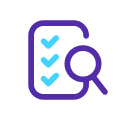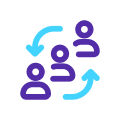Download our E-BOOK
App-solute Musts: 10 Key Components of a Successful App
March 27, 2023
by Ashley Rondeau
In today’s world, mobile app development is an essential part of any online business. Mobile apps provide users with solutions that make their lives easier, more efficient, and more enjoyable. Although many apps start with fantastic ideas and concepts that seem promising, the journey from conception to success is not always straightforward. In reality, many apps face significant challenges and obstacles along the way. As such, it’s essential to understand that not all apps are equal and that building a successful app requires more than just a great idea.
As a diverse team of app developers, designers, and product managers here at Rocket Farm Studios, we know that creating a successful mobile app is no easy feat. That’s why we dug deep, pulled out our thinking caps, and together we narrowed down the top 10 crucial components for building a successful app.
So, let’s review our 10 “app-solute” musts that your app needs!
1. User Experience (UX)

User experience (UX) focuses on the overall experience that a user has when interacting with an app, including how easy it is to use, and how well it meets the user’s needs. When an app has a seamless and enjoyable UX, it creates a positive perception of the brand, which can lead to increased user engagement and brand loyalty, and ultimately trust.
The ultimate goal of UX is to create a satisfying and rewarding experience for the user so that they will want to return time and time again.
Creating an efficient UX design is the first step toward your app’s success and should always be a top priority for your app development. To create an effective UX design it is essential to thoroughly research your intended target audience. You will first want to focus on the problem that your app is trying to solve for them and then focus on their needs, preferences, and behaviors.
“UX design is about delighting users by anticipating their needs and giving them something they didn’t think to ask for.” –Reed Jones
App users prefer to use applications that are engaging, entertaining, and easy. Most successful applications such as TikTok and Instagram for example offer their users seamless and pleasant experiences, as well as a simple-to-navigate and visually attractive user interface.
By prioritizing user experience in the development process and continuously iterating and improving the UX over time, developers can create apps that meet the needs of their users and stand out in the market.
2. User Interface (UI)

Visual Design compliments UX, it brings in the notes and the essence of your brand. It creates that distinction for the eye to process. So if you’ve ever tried to use a new app or function on your smartphone and thought to yourself, “How do I do this?” that is the question that UI designers seek to answer.
They help ensure users can easily interact within the application and predict how and when they will do so. Unlike UX design which focuses on the user experience, UI design focuses on aesthetics. This includes the app’s look and feel, such as the colors users see, the animations they interact with, the visuals of the buttons they press, or the font text they read. UI designers work to create a layout and design that makes it easy for the user to navigate the product, find the information they need, and complete their desired actions.
While designing your UI, you should avoid taking control away from users, and instead empower them to complete desired tasks and actions. This helps them feel comfortable with the product and encourages quick learning and mastery. It should also allow users to quickly undo mistakes, so they can explore new options without feeling fearful.
Good UIs also provide the user with a sense of control which in turn makes the user comfortable and helps them gain what they want quickly.
By creating a well-designed and intuitive UI, designers can improve user engagement, satisfaction, and retention, leading to a more successful product. The visuals bring the brand to life, but draw attention through animation. Use animations judiciously to accomplish tasks to give them a sense of accomplishment.
3. Functionality

Performance is important in app development because it affects how well the app works and how users experience it.
Functionality refers to the features and capabilities of an app that allow users to achieve their goals and accomplish specific tasks. The success of an app depends on its functionality, as users expect the app to work smoothly and efficiently, without any bugs or glitches.
Have you ever experienced a slow or glitchy app and quickly became frustrated? This is exactly what you want to avoid for your users!
If the app is slow or crashes frequently, it will frustrate users and make them less likely to use it.
When developing an app, it’s crucial to prioritize key features that will provide a seamless user experience.
When it comes to building a successful mobile app, having the right feature set is essential. It’s crucial to ensure that the app’s features meet the needs of the target audience and provide real value to users. One of the best ways to do this is through user testing, which can help validate the feature set and ensure that it aligns with user needs and expectations.
But even with the best UX and UI, you won’t truly know if your features are right until you release your app to the public. This is why it’s important to have everything wired from an analytics perspective, so you can track user behavior and measure the success of your features. By doing so, you can iterate and make changes to improve the app’s performance and user satisfaction.
In addition to having the right feature set, it’s equally important to ensure that the app is well-built and free of bugs. No matter how great your app’s features are, a buggy app can quickly turn off users and erode their trust in your brand. To avoid this, it’s crucial to have a robust testing process in place that covers all features across different operating system versions, device types, and other variables that can impact the app’s performance.
4. Performance

No one anywhere has ever said, “I hope this app is really slow.” In the world we live in today we have come to expect technology to not just perform well, but FAST. Anything less is generally cast aside.
Performance is an essential aspect of app development as it directly affects the user experience. Users expect apps to be fast, responsive, and efficient, and they will quickly lose interest if they are slow, buggy, or unresponsive. When a button is clicked or a swipe is made the app should respond instantly to the user’s expectations.
Performance-wise, a key metric is an app’s response time. Ideally, the app should have a response time of around 100 milliseconds back to the user, as anything longer can negatively impact the user experience. However, it’s important to note that servers may not always respond within that time frame, so having a responsive UI that displays a spinner or loading icon during data requests can help keep the user informed.
Instrumenting all calls on the server is also crucial to optimize app performance. This enables you to be aware of server performance and make data-driven decisions to improve it. It’s important to remember that performance is an end-to-end pursuit, and with modern cloud architectures, it’s easy to scale by adding hardware. However, bottlenecks may still occur under certain load conditions, so it’s important to continually monitor and optimize performance.
Optimizing code can help reduce load times, improve speed, and ensure the app doesn’t lag or freeze annoying users. As an app continues to grow and change, optimized code can also help ensure that it can handle increased traffic and load without experiencing performance issues.
5. Security

Data breaches are a serious threat to any business, regardless of its size or industry. A data breach can occur in many ways, from cybercriminals hacking into your system to an employee accidentally sharing confidential information. The cost of data breaches is rising each year, and the average cost of a data breach for a company is now over $4 million. This includes costs associated with investigating the breach, notifying customers, and implementing new security measures to prevent future breaches. It’s not just the direct costs that can be expensive; the indirect costs, such as lost revenue and damage to your brand’s reputation, can be even more significant.
Whatever the cause, the consequences of a data breach can be catastrophic.
In this day and age, security is of great importance when developing your mobile application which is why security has to be on this list. So much that could go wrong happens when security is not in place. If your app is hacked, your customers could be harmed and worse it could sour your reputation.
- One way to protect data from unauthorized access is to encrypt it using a secure encryption algorithm. This can help to ensure that the data is not easily accessible by unauthorized individuals. All server traffic is encrypted to ensure that calls are secure and protected from interception by unauthorized third parties. This includes not only calls to and from the server but also any other traffic that passes through the server.
- Whenever possible, customer personally identifiable information (PI) is not stored to minimize the risk of a data breach. This information includes any data that could be used to identify an individual, such as name, address, phone number, email address, and social security number. If it is necessary to store customer PI, it is stored securely using industry-standard encryption and access control measures. This includes limiting access to the data to only those employees who require it and enforcing strong password policies.
- Backup and recovery steps are in place to ensure that data can be restored quickly and efficiently in the event of a data loss or breach. Regular backups are taken and stored in secure locations, and recovery procedures are tested regularly to ensure that they are effective.
- Interconnections to third-party services are carefully vetted and secured to ensure that they do not pose a risk to the security of customer data. Third-party services are required to adhere to the same high standards of security and privacy that are in place for our own servers.
Best practices for running a secure operation are followed, including limiting access to sensitive data, enforcing strong password policies, and regularly reviewing access logs and audit trails to detect any unusual activity. These measures are designed to ensure that the operation remains secure and that customer data is protected at all times.
So by following best practices for app security and implementing encryption to protect sensitive user data, developers can help ensure that their apps are secure and trustworthy, which can lead to increased user confidence and adoption.
Running systems and ensuring their security, is a complex and ongoing process that requires constant vigilance. Phishing is just one of the many security threats that businesses and individuals face today, and it is essential to be proactive in protecting your systems against it.
6. Monetization

Monetizing an app helps generate revenue, enables app improvements, increases user engagement, provides valuable data, and supports long-term sustainability. By developing a monetization strategy tailored to the app’s audience and features, developers can create a successful app that generates revenue and provides value to its users.
Many app developers make the mistake of following an ‘if we build it they will come strategy’. They focus solely on building a large user base and assume that they will figure out how to monetize the app later. Unfortunately, this strategy is rarely successful. Part of building the right feature set for the right market is having a monetization model that makes sense for the specific users of the app. It’s crucial to test whether users are willing to pay for the perceived value of the app.
There are many different ways to monetize an app. Some of the typical strategies include charging an app purchase fee, offering a subscription model, implementing in-app purchases, and selling different types of consumables. Each monetization model has its pros and cons, and the best approach depends on the nature of the app and the preferences of the users.
For example, an app that provides a one-time service or solution may be best suited to charge an upfront app purchase fee. On the other hand, an app that provides ongoing value or content may be better suited to a subscription model, where users pay a recurring fee to access the app’s content or features.
In-app purchases, such as unlocking additional features or purchasing virtual currency, can be another effective monetization strategy. However, it’s important to be transparent with users about what they are paying for and to avoid making the app feel like it is pushing users towards spending money.
Finally, a successful app monetization strategy requires careful consideration of the app’s features and target market. By offering a monetization model that makes sense for users, app developers can ensure that they are providing value while generating revenue.
When considering monetization strategies, it’s essential to consider whether charging outside of the Apple or Google payment systems is appropriate. While it may be tempting to avoid the fees associated with these payment systems, it’s important to ensure that any alternative payment methods are secure and transparent for users.
7. Marketing

Without marketing efforts does your app even really exist? Even the most well-designed and feature-rich apps will not succeed if users are not aware of them or motivated to download and use them.
Ask yourself the following:
- Do you know who your customer is?
- Do you know their pain points?
- Do you know what their needs are?
- Do you know how your app solves your user’s concerns?
Famous consultant Peter F. Drucker said, “The aim of marketing is to know and understand the customer so well that the product or service fits him and sells itself.”
Were you able to answer those questions? Do you know who you will market your app to and why? Many people believe that casting a wide net is the best way to catch more fish, but more isn’t necessarily what is most effective. The most successful fishermen know the type of fish (or lobster or crabs) they plan to catch ahead of time! They plan their strategy, know exactly where to find them, and when to strategically deploy their “nets/traps” to catch them.
Identifying clearly defined target markets and audiences allows you to hone in on the most critical potential users so right off the bat you are going after those big/impactful fish.
With millions of apps available in the app stores, getting your app noticed can be a challenging task. This is where app marketing comes into play. Effective app marketing involves a range of strategies and techniques, including ASO (App Store Optimization), app store presence, SEO (Search Engine Optimization), keyword research, and user-lifecycle management.
Furthermore, a successful app marketing strategy requires a consistent brand message and user experience across all channels, from social media and email campaigns to in-app messaging and customer support. By integrating all aspects of your brand and messaging across the user lifecycle, you can create a cohesive and impactful marketing campaign that drives downloads, user engagement, and revenue.
Lastly, as marketing technology continues to evolve, app marketers need to keep up with the latest tools and techniques to stay ahead of the competition.
User personas are a critical tool for app marketers as they help to identify the target audience and create tailored marketing messages and user experiences. By understanding the needs and preferences of different user segments, app marketers can increase user engagement, drive downloads, and ultimately, improve the app’s overall performance. Curious about who your intended audience is? Find out here.
8. Maintenance

Just as you go to the doctor’s every year for a checkup, your mobile app will need the same, but a bit more often! Key to a healthy process is continually fixing bugs and issues reported by your users, as well as staying on top of any updates that might be driven by updates from Google or Apple. The mark of a healthy app is one that has frequent releases. If you’re doing things well you are continually tweaking everything in-app and off-app to gain incremental improvements everywhere in the user lifecycle.
Your users will thank you and your metrics will too.
Bugs are an inevitability of software development. Even in the cleanest code, there can be one tiny issue that causes your app to not function properly or even crash.
Frequent checks and fixes can prevent your users from spotting them first and uninstalling your app from their phones. By maintaining your app, you can combine bug fixes with new feature releases on a regular cycle.
Make it a priority to regularly update your app and actively monitor user feedback. This approach can help identify and address bug fixes, as well as provide valuable insights for future feature requests. Ultimately, this will lead to improved user satisfaction and retention, as well as continued success for your app.
9. Deployment

Application deployment is one of the most important stages of the software development process. The strategy that is used to build, test, and deploy directly impacts how fast an application can respond to changes in constituent preferences or requirements, and most importantly—the quality of each change.
It is essential to test your app regularly during deployment to ensure a seamless user experience.
The deployment phase involves packaging the app, uploading it to an app store or a web server, and making it accessible to users. The deployment phase is crucial because it can significantly affect the user experience, app performance, and overall success of the app.
We’ve seen how pre-deployment and post-deployment QA (Quality Assurance) are both critical components of a successful software development process.
- Pre-deployment QA involves testing the software before it is released to identify and fix any bugs or issues that may impact the user experience. This ensures that the software is stable and functional before it is made available to users.
- Post-deployment QA involves ongoing testing and monitoring after the software is released to ensure that it continues to perform as expected and that any new issues are promptly addressed.
Basically, every deployment is your app walking on stage again – you want it to be perfect. A well oiled software team will thoroughly test prior to release, make sure everything is working after release, and then continually monitor in the hours following for any user issues that you didn’t catch in your testing. A well oiled team will always publish easy to read helpful release notes so your users will know what’s changed.
By implementing a comprehensive QA strategy that includes both pre-deployment and post-deployment testing, software teams can improve the quality of their products and deliver a better user experience.
10. Analytics

When it comes to apps, data is extremely important and useful to help you better understand your users, their behavior, and their demographic information. Without it, you won’t be able to test and improve your application.
Analytics provides valuable information about user behavior, such as how users navigate the app, which features they use most, and which ones they ignore. This information can help developers identify areas for improvement and to make informed decisions about how to enhance the user experience.
Analytics also allows a closer, more in-depth look into the performance of your app, including metrics such as load times, crashes, and user engagement. This information is critical for developers to identify and address any issues that may be hindering the app’s performance.
By analyzing user behavior and app performance, developers can identify areas where the app can be improved, and new features or functionalities that would be useful to users.
Data-driven decisions can also improve your application by analyzing user data and app performance. Developers can make informed decisions about which features to prioritize, which bugs to fix, and how to optimize the app for better performance and user engagement.
Monitor and analyze user data to continuously improve the app and user experience. Here are just a few of our most used analytics tools.
In Conclusion
App development is a complex and constantly evolving process, requiring careful planning, execution, and ongoing maintenance. If it was simple everyone would do it, right? While there are countless components to a successful app, one thing is clear: to achieve and maintain success, you must have a process that allows for continuous iteration and improvement.
This means carefully planning your app strategy, executing on that plan with precision, and constantly monitoring and maintaining your app to keep it at the forefront of the market.
By following our 10 app-solute musts, you can build an app that not only meets the needs of your users but also drives growth and success for your business.
Also, it never hurts to have a little help launching your app in the right direction!
Related Blog & Posts

How to Increase conversion in 2025
With over 25 years in technology and product development, Dan leads Rocket Farm Studios with a commitment to innovation and growth.
Ready to turn your app idea into a market leader? Partner with Rocket Farm Studios and start your journey from MVP to lasting impact.”
Teams for App Development
We help companies build their
mobile app faster with go to market strategy

Technology and UX Audits

Early Design Sprints

MVP Creation

App Store

Growth Teams
Download Our Free E-Book
Whether you’re launching a new venture or scaling an established product, Rocket Farm Studios is here to turn your vision into reality. Let’s create something extraordinary together. Contact us to learn how we can help you achieve your goals.






